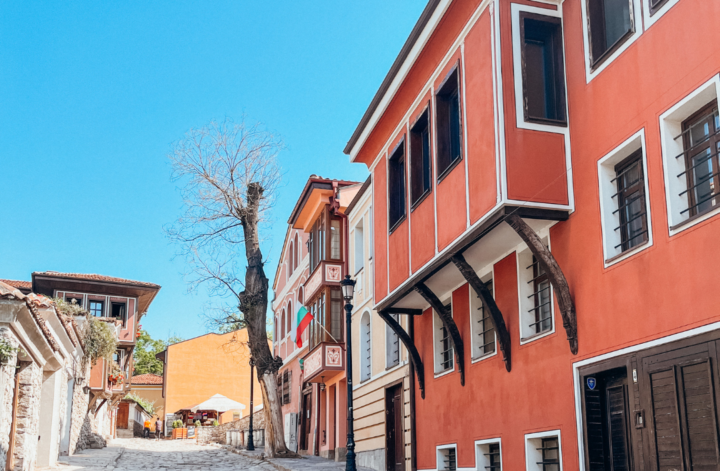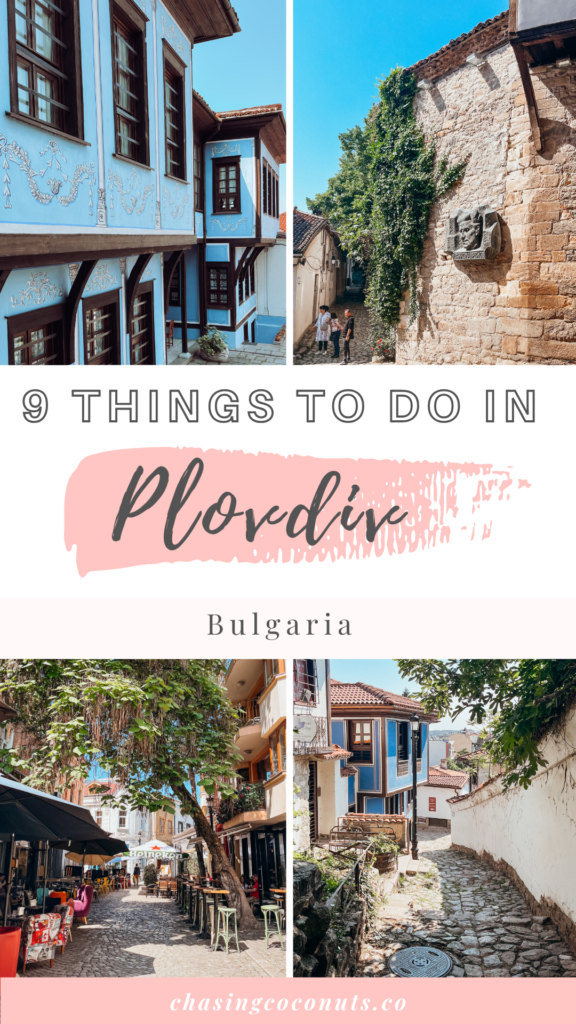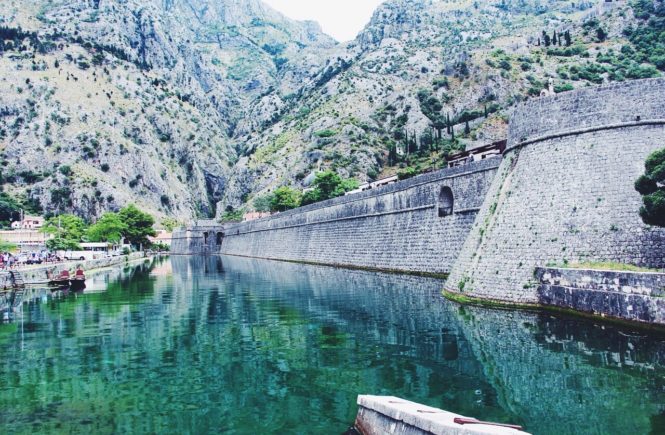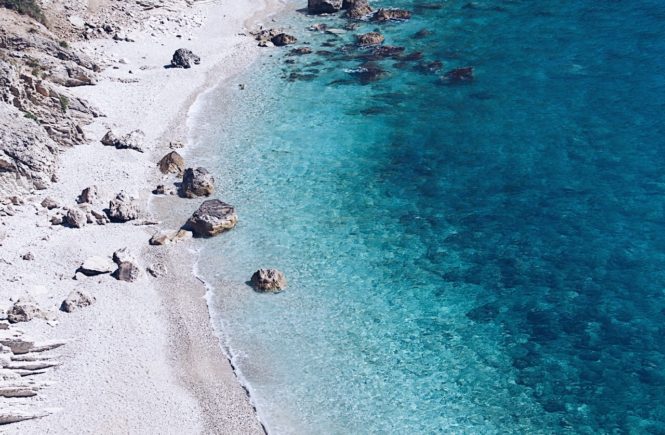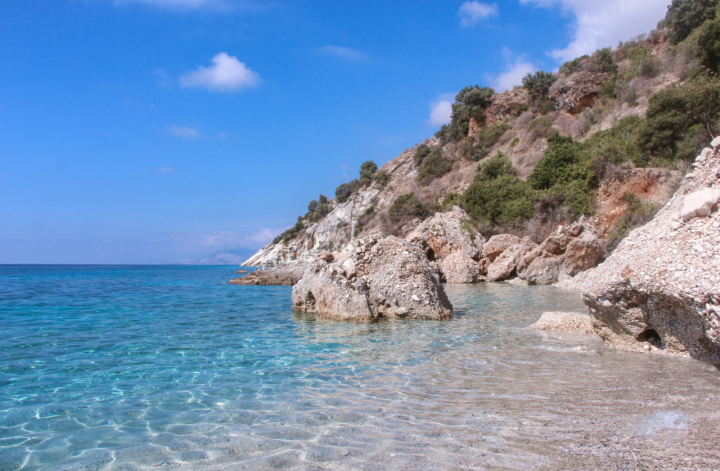Plovdiv is an ancient city nestled in the heart of Bulgaria. It is the second largest city in Bulgaria (behind Sofia) and blends ancient history with a vibrant modern culture.
Fun fact: Plovdiv is the oldest living city in Europe and the 6th in the world! The history of this city spans 8 millennia!!
I spent one day in Plovdiv (as a solo traveller) on my way to Rising Soul Retreat in Bulgaria and was surprised by how beautiful, colourful and charming it was.
Expect cobblestone streets, Roman ruins, quaint architecture and a bustling art scene. Plovdiv is proving itself to be an incredible up-and-coming European destination to capture enthusiasts of history, charming architecture, art and nature.
The origins of Plovdiv can be traced back to ancient times when it was known as Philippopolis. Throughout its long history, Plovdiv has been influenced by several civilisations including the Thracians, Romans, Byzantines, Ottomans and Bulgarians. Making this a destination rich in overlapping and diverse architecture, traditions and customs.
The top things to do in Plovdiv are:
- Wander through the Old Town
- Discover Roman ruins at the Ancient Theatre
- Mevlevi Hane Dervish Monastery
- Immerse yourself in art & culture in the Kapana neighbourhood
- The Dzhumaya Mosque
- See the Sunset at one of the hills
- Visit the Balabanov and Hindlian Houses
- See the Church of St. Constantine and Helena
- Visit the Regional Ethnographic Museum
Keep reading to discover more about the top 14 things to do in Plovdiv that will leave you spellbound.
1. Wander through the Old Town
The Old Town is situated on top of three hills. When exploring this beautiful place you will stumble upon many of the things to do on this list!
If there is one thing you can’t avoid doing in Plovdiv, it is to explore the charming Old Town. This UNESCO World Heritage site is a maze of ancient architecture spanning 2000 years.
Stroll through the cobblestone streets and discover the treasure trove of history waiting for you.
Expect narrow streets, colourful Renaissance houses, ancient Roman ruins, medieval architecture, quaint shops, art galleries, museums and cute cafes to recover in. Oh and roses, a whole lot of beautiful rose bushes.
The Old Town is a great place to stay – I stayed at Boutique Hostel Old Plovdiv. However, it comes with a warning! Taxis (not the friendliest folk in Bulgaria) won’t drive into the old town. This means you will have to walk to your hotel or hostel which is extraordinarily uncomfortable if you have heavy luggage. The streets are extreme cobblestones with very uneven pathways and it’s all up and downhill. Just so you know and don’t almost unexpectedly die like me getting to and from the airport/train station!

2. Discover Roman Ruins at the Ancient Theater
You don’t have to go to Rome to discover ancient Roman ruins! In Plovdiv, you will find a well-preserved Roman Theatre that dates back to the 1st century. This theatre is steeped in sorted history – it used to hold gladiator fights and theatrical performances.
Today it is used as a venue for concerts, operas and festivals providing a unique opportunity for us modern folk to experience performances in such a historic setting.
The theatre is located centrally on Dzhymaya Square and is also perched on a hill making it an easy place to explore the city’s other attractions (and see a nice view). You need to buy a ticket to explore inside but you can get a pretty decent view from the outside.

3. Mevlevi Hane Dervish Monastery
This building (which is now functioning as a restaurant) belonged to the Mevlevi Order of the Sufis. This dervish monastery is the only one of its kind and is very unique in Bulgaria.
The Mevlevi order was around when the Ottoman Empire ruled Plovdiv but died out at the end of the 19th century.
In this building, the hall is left which is where the Sufis performed their famous dances.
4. Immerse yourself in art & culture in the Kapana neighbourhood
Kapana means ‘a trap’ in Bulgarian. It was named this due to the ways the streets cross, change direction and lead to dead ends. Sounds like a fun little spot to get lost!
The centrally located Kapana neighbourhood has been transformed into a trendy area full of art galleries, boutique shops, craft beer and hip cafes. Kapana is considered the creative hub of Plovdiv and is an excellent place to mingle with the locals and soak up the vibrant atmosphere.
Attend exhibitions and workshops, try out the trendiest restaurants and if you are there at the right time of year don’t miss the annual Night of Museums and Galleries. This is a cultural extravaganza that showcases Plovdiv’s art scene on the streets.
I loved walking through this neighbourhood. It felt like ‘the’ place to be with lots of people enjoying the cafe and restaurant scene. There are lots of shops and even vegan restaurants. I went to Veggic and it was actually really good and their menu was incredible. This definitely surprised me! My suggestion is to explore the area and go to whichever cafe or restaurant you vibe with.

6. Dzhumaya Mosque
This is the main Muslim mosque in Plovdiv and is located in the centre of the old town. It was built in place of the Cathedral Church after Plovdiv was conquered by the Ottoman army in the 1300s. This is one of the oldest religious buildings in the Balkans! it is also one of the biggest, making it impressive visually and historically.
If you love Turkish culture, there is a Turkish cafe located next to the mosque where you can enjoy Turkish coffee, tea and treats. The square and streets surrounding the mosque are beautiful and interesting to explore, with ruins just randomly scattered everywhere.

7. See the sunset at one of the hills
Like Rome, Plovdiv was built on seven hills (only 6 remain). Climb any of the hills before the sun goes down to watch the sunset over Plovdiv.
I climbed the Bunardzhika Hill which gave me great views and wasn’t too much of a hike from the old town.
Gebet Tape is the highest hill in the old town and a great choice as you can also see the remains of the ancient Thracian Fortress.
These prehistoric ruins date back to the Neolithic era 8000 years ago! Watch the sunset with a side of one of the oldest ruins known to man. When I visited this site was closed so I didn’t see but maybe it will be open when you go.
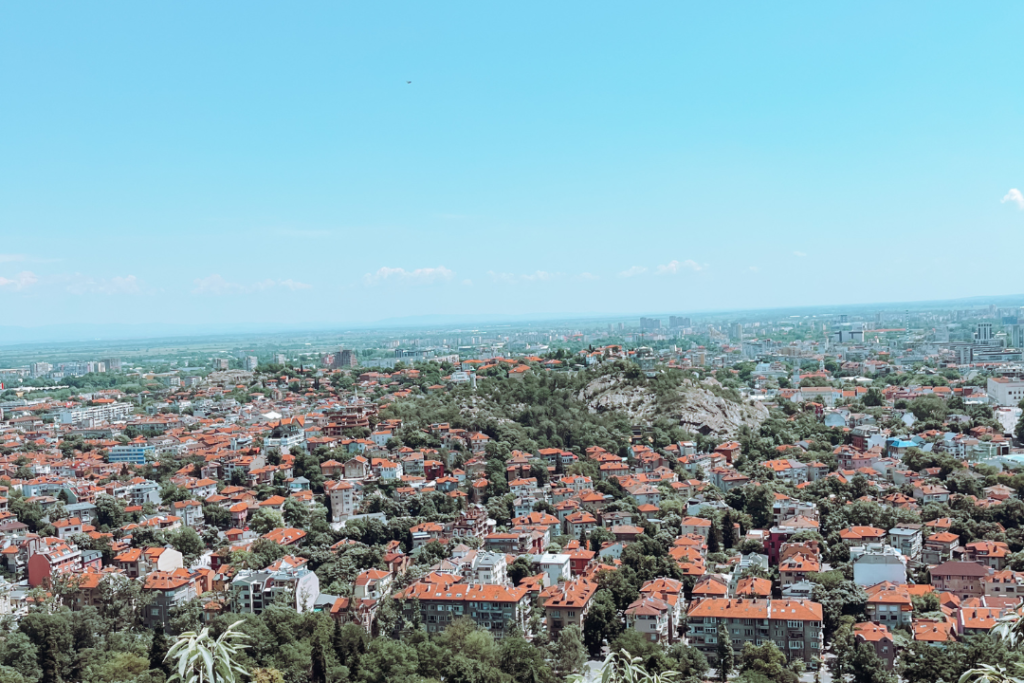
8. Visit the Balabanov and Hindlian Houses
These two houses used to belong to rich merchants and feature interesting baroque furniture and carved wooden ceilings. They are a great way to get an interesting glimpse into how the other half lived in the 19th century.
I walked past both but only had time to go inside the Balabanov’s house. It was worth the entrance ticket to see all of the rooms inside. It was perfectly beautiful and creepy all at the same time!
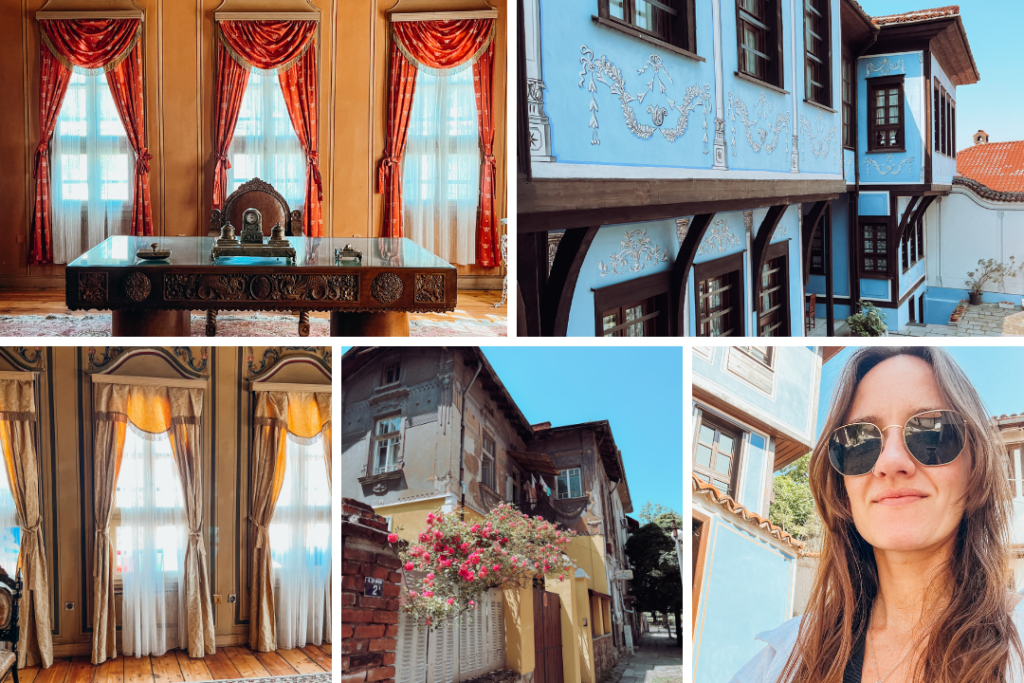
9. See the Church of St. Constantine and Helena
This church dates back to 337 AD, making it one of the oldest in Plovdiv. It has been reconstructed over the years with the current building and baroque interior dating back to 1832. This church was located right where I was staying and was so beautiful from the outside. All of the winding streets in the old town around this church are also very beautiful and interesting to explore.

BONUS Sample Bulgarian cuisine
Plovdiv is one of the best places in Bulgaria to sample the best food the country has to offer. Bulgarian cuisine is a blend of Balkan and Mediterranean food with hearty meat dishes, cheesy pastries as well as fresh Greek-style salads.
You can’t indulge in Bulgarian cuisine without washing it all down with a glass of rakia, Bulgaria’s version of brandy. As mentioned above you can even have a vegan variation of Bulgarian food! The quality of the food in Bulgaria is very high with a focus on seasonal and locally grown produce. Oh and it is cheap – very cheap!
How long do you need in Plovdiv?
It’s possible to see all of the main attractions listed above in 1-3 days. However, staying for 3-5 days will give you enough time to really soak up all that Plovdiv has to offer and to really get to know what it would be like to live there.
Factor in an extra day or two if you would like to explore the nature of the surrounding Rhodope Mountains.
Remember that Bulgaria is budget-friendly so don’t shy away from an extended stay to make the most of it.

Getting tickets to attractions
You can buy tickets to individual attractions or if you want to see a bunch it’s worth getting a combined ticket where you can see 5 sites on one ticket. Find more info here. The combined ticket is 15BGN (~ 7.50 euro), so it is very affordable!
When is the best time to visit Plovdiv?
June to August are the hottest months with the best weather but are the busiest & most expensive. It is a great destination in the shoulder season from April – May and September – October for the best weather & prices. At the very beginning of June, when I went, it was already getting very hot so I can imagine it would be uncomfortably scorching during July and August.
How to get to Plovdiv
There is an airport in Plovidiv so if you’re lucky enough you may be able to get a flight directly there. From the airport, there are shuttles or taxis to the centre (there is an ATM in the airport which you will need to use to get local currency to pay for your journey to the city).
If you are coming from Sofia or somewhere else in Bulgaria you can either get a train or a bus to Plovdiv which you are able to book online. You can also buy train tickets at the station.
Things to know about the trains in Bulgaria as a solo traveller
I found Bulgaria to be one of the most challenging places to catch a train in the world. The stations have all the signs in Bulgarian and the timetables, boards, platforms etc are all incredibly confusing and don’t seem to make sense. To top it off hardly anyone speaks a word of English and in general the workers at the station are very unhelpful.
Make sure you check timetables beforehand to know what time your train should be and if you are having trouble at the station, I found the most helpful and friendly people to be older ladies so try approaching them if the staff basically tell you to f**k off.
I was actually in tears by the time I finally got on the train in Plovdiv!! Also, the trains are VERY old and you have to basically climb a ladder to get on – so keep this in mind if you have heavy luggage. Don’t count on someone helping you!

Things to know about taxis as a solo traveller
The taxis in Plovdiv run on meters so make sure your taxi is on the meter. Don’t get in a taxi with someone who quotes you a price in EUR as you will be getting ripped off. The taxis are actually very well-priced.
Also just know that the taxi driver may come across as very grumpy and unwilling to drive you anywhere. Match their energy and advocate for yourself and also know exactly where you need to go and you should be fine.
When I arrived at the train station on the airport shuttle, it was actually really hard to even find a taxi – there wasn’t a full taxi stand. One taxi driver tried to rip me off big time. Luckily a friendly older woman helped call a taxi for me and communicated with the driver where I needed to go (he really didn’t want to take me!!). I made it to the hostel in the end, but it was a struggle and in hindsight, I probably just should have taken a taxi directly from the airport.
Maybe I had bad luck but other people I spoke to had similar issues with the trains and taxi drivers in Plovdiv.
I wish someone had told me this before I went to Bulgaria so I knew what to expect. It can be quite a culture shock as well if you haven’t spent much time in the Balkans before or are just landing from an overly polite place or a place where everything functions well.

